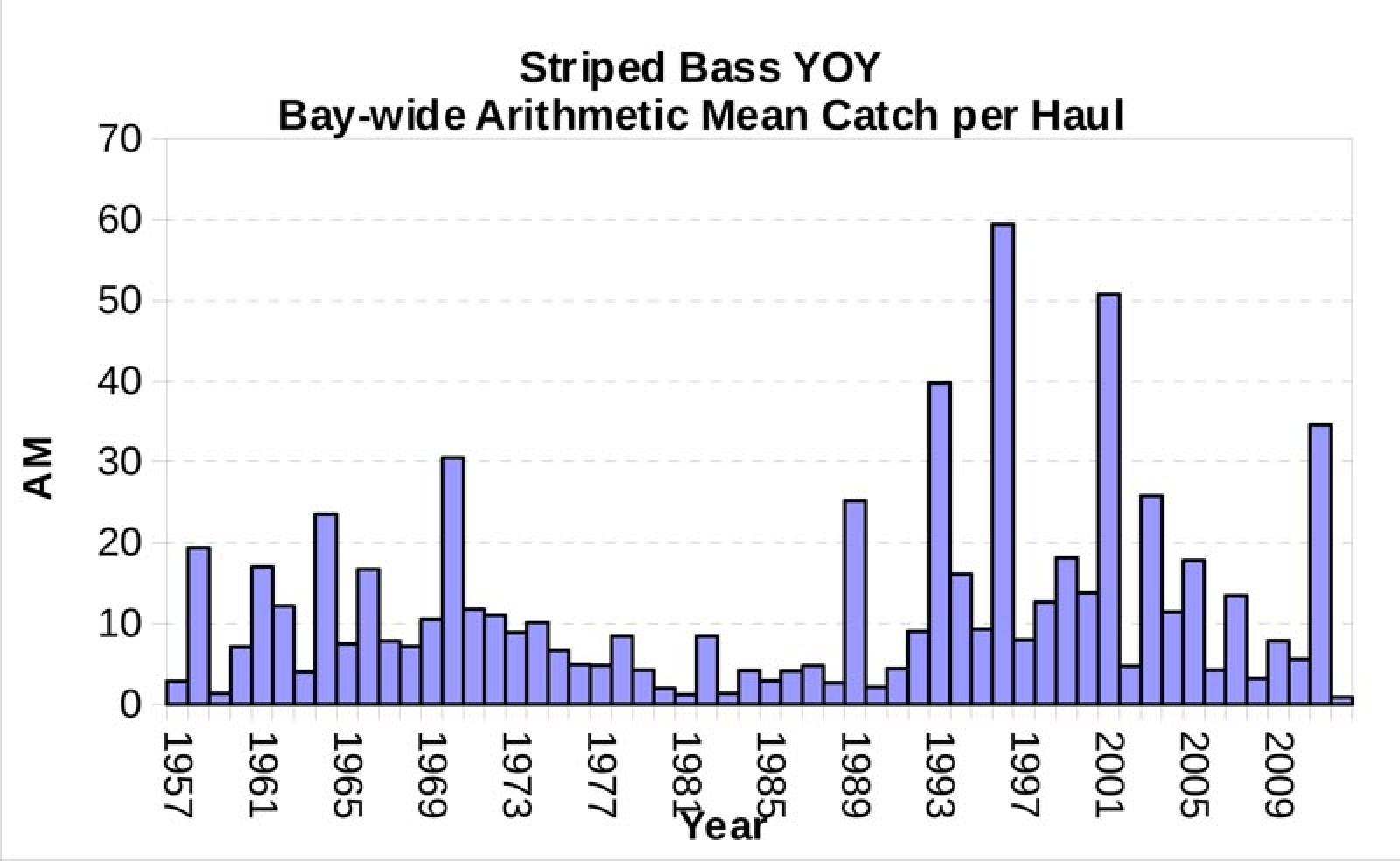Juvenile striped bass spawned in the Chesapeake Bay were at a record low at the end of the summer. The Maryland Department of Natural Resources recently completed its annual young of the year survey and found far fewer juvenile fish than a year ago.
Scientists believe the factors are more tied to unusually warm weather conditions in the Chesapeake than to the number of adult fish spawning in the bay.
The annual survey of fish spawned in the summer is called the young of the year index, and is used to gauge the health of stocks born in that year. The annual index, collected over more than 50 years, has had many highs and lows. This year’s index, the lowest recorded, was .89. Last year’s index of 11.9 was the fourth highest.
Nearly all striped bass found in Vineyard waters come from the Chesapeake. It can take from four to six years for a female striped bass to reach sexual maturity.
Dan McKiernan, deputy director of the state Division of Marine Fisheries, called the low index troubling and said it may be tied to environmental factors, since the water temperature in Chesapeake Bay was especially high this summer. Mr. McKiernan said the number of adults spawning in the bay didn’t change that much from last year. He said the index shows how well those juvenile fish survived by the end of the summer, not how many fish were spawned.
“What it tells you is that there is high variability. You see a swinging pendulum. I am not a climatologist, but it would seem that the wild swings are tied to the environment,” Mr. McKiernan said. “Whether you look at the temperature of the water or the amount of rainfall, you’ve got dramatic swings . . . the Chesapeake Bay had one of the hottest years,” he added.
Mike Armstrong, a fisheries biologist and assistant director of the Massachusetts Division of Marine Fisheries, underscored the significance of the striped bass fishery. “It is the recreational fishery in Massachusetts,” he said. “We live and die by the health of striped bass, so we are watching the stocks like hawks.”
The Atlantic States Marine Fisheries Commission, a regional government agency, has been monitoring the striped bass fishery closely since stocks collapsed 30 years ago. Recently, the commission decided to take steps to tighten controls on management of the fishery.
The abundance of striped bass is not determined by a single year class, Mr. Armstrong said, but by watching larger trends. “We are not pushing the panic button. But if we have three years in a row like this, then we push the panic button,” the fisheries biologist said.
Also, new trends were observed this summer. Mr. Armstrong said fishermen saw many more schoolie-sized striped bass in Massachusetts waters than would normally be expected.
He said scientists are wondering whether the large 2011 year class still swimming in the Chesapeake Bay had something to do with the change by pushing the larger juvenile fish out into the Atlantic.
Janet Messineo of Vineyard Haven, an avid fisherman and past president of the Martha’s Vineyard Surfcasters Association, confirmed the trend from her experience fishing the derby this fall. “There were more small fish out there,” she said. “We should be concerned [about the low index] but I think we really need to make sure that the fish are in a healthy ecosystem,” she added. “Right from the get-go, we should be thinking of the bait, from microorgansims to bunker [menhaden, a valuable bait fish that has been characterized as overfished and in need of restoration]. We cannot go crazy over just one species. We have to look at the whole picture if we want a healthy fishery.”
She continued: “The good thing I saw [this year] was that there were bunker. I haven’t seen bunker in a lot of years. One of the problems with striped bass we’ve seen in the past is that they were skinny and emaciated. This year we saw healthier fish. My concern isn’t that there be a large number of fish out there. I think we should be concerned that they have food to eat.”






Comments
Comment policy »